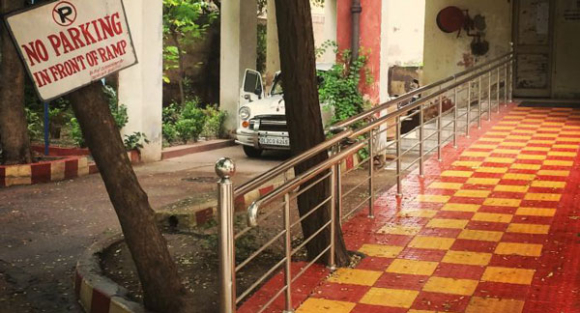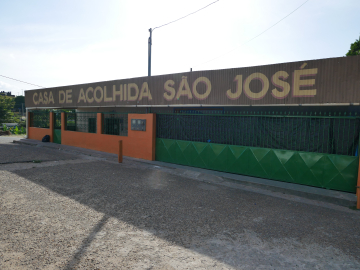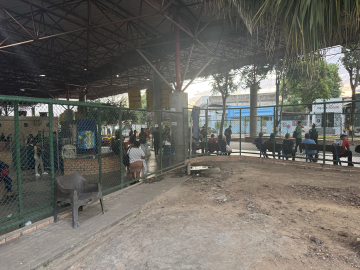How Language Shapes the Disability Experience in India
One day Madan Vasishta is deaf—the next, divine.
Nothing special happened to him. He experienced no moment of religious clarity…no metaphysical encounter. This is simply the result of the introduction of a new label by the Indian government.
Meaning “divine body,” this Hindi word has been adopted by Prime Minister Narendra Modi to identify a person with disability. The idea that one’s disability has, in one semantic shift, become a measure of godliness, is a linguistic change India’s disabled view as a patronizing act—further entrenching barriers between those with and without disabilities. “My ears are not God’s ears,” Vasishta responds.
Labels have long been woven into the cultural fabric of India, as seen in the legacy of the caste and colonial systems. One’s surname alone can identify that person’s religion and mother tongue. The words people use to mark identity not only shape social inclusions and exclusion, but are also reflected in the systems governing accessibility and education.
According to the 2011 census, 2.21% of India’s population is disabled, compared to the estimated 15% average global disability prevalence. The discrepancy, explain Sanjay Prasad and Rakesh Rao, both Deputy Chief Commissioners for Persons with Disabilities, could be in part due to the categorization of disability.
This census, Prasad says, “covered four types of disability: orthopedically handicapped, hearing handicapped, low vision, or mental disability.” While the legislation has since expanded to cover seven categories, such narrow definitions limit an accurate reflection of the current scope and nature of disability in the country.
Rajiv Rathuri, a disability activist, sums up the implications of these restrictive definitions, stating, “If you are not counted, you don’t matter…you are outside the social net.”
These labels not only fail to capture accurate data on disability prevalence, but also influence how individuals with disabilities receive government services.
In order to gain admission to institutions serving persons with disabilities, or file cases about accessibility with the Office of the Chief Commissioner for Persons with Disabilities, one has to obtain a “Disability Certificate.” In order to legally identify as disabled, Prasad and Rao explain, the person must be “40 percent disabled”—an ambiguous distinction that is no doubt being interpreted differently across the country.
Beyond the social stigma of applying the “disabled” label, the hurdles to obtain the certificate are steep. A well-resourced person can understand the process and pay doctors’ fees, but still must navigate an inaccessible environment to meet appointments.
A person without income to pay for a doctor, or illiterate and struggling with the paperwork, may pursue the certificate for years. This was the case for Rima Prajapati and Salim Ansari, both parents of children with disabilities living in Shivaji Nagar, a Mumbai slum. It took Prajapati two years of persistence to obtain the certificate for her deaf daughter. Ansari had the support of a local NGO, Apnalaya, to obtain the certificate for his intellectually challenged son.
Both parents persisted, however, because obtaining this certificate, thus legally identifying their child as disabled, allowed them to access special schools.

Wheelchair ramps are not often seen in many Indian cities. This ramp is is at the Office of the Chief Commissioner for Persons with Disabilities. Kate Petcosky-Kulkarni/New Delhi, India, 2016.
Unlike some countries, where education falls under one department, the “education for people with disabilities is the domain of two ministries,” Rathuri states. “The Ministry of Social Justice and Empowerment…takes care of special schools, and the Ministry of Human Resource Development (MHRD) takes care of inclusive education.” Such a dichotomy is not in the interest of the child, Rathuri explains, because “you have two central ministries looking after education for disabled children.”
Rather than two groups promoting a student’s education, a child must switch from one to another based on the label he or she receives. Shamin Mehrotra, a counselor at the Umeed Foundation, explains that many parents fear a diagnosis because it could result in a school withdrawing their child’s admission. In a city as populous as Mumbai, there are precious openings in schools serving special needs, and the idea of “inclusive education” is mostly just that. Teachers at schools falling under MHRD, according to Mehrotra, are in “already overburdened classrooms” and do not feel prepared to support students with disabilities. Thus, parents fear acknowledging a disability or demanding inclusive education, Mehrotra says, asking “What is point of advocating if your kid will get kicked out of their school?”
So, the label of disability is a prerequisite to receive services, but can also be a liability in terms of educational access, leaving one to question how India’s disabled self-identify and wish to be identified by others...coming back to Modi’s divyang.
“Some sections are ok with it—especially people from rural backgrounds,” says Rathuri, but he views divyang primarily as the prime minister’s attempt to win favor after touting derogatory remarks about disabilities during his 2014 campaign.
Nilesh Singit, a disability activist with cerebral palsy, understands the messiness of identify and language in India. An alumni of the Spastic Society of India, whose name alone shows antiquated terminology, he takes a unique stance on the notions of person-first language (identifying ‘a person with condition’) and political correctness that pervade most of the Western conversation about disability rights.
“So they say the ‘right thing’ but the discrimination will never stop,” Singit explains. “I prefer someone calling me a spastic, and being treated correctly, than being called a ‘person who has spasticity’…and mistreating me.”
Part of this, he explains, is the nature of a Bombayite: “We call all kinds of nasty things to each other, or in general, without having compunction.” More so, however, he feels he needs to meet people at their level. While travelling throughout Mumbai by taxi, he relies on drivers to handle his wheelchair. “I used to talk about person-first, but with these guys, I never did that. I talk to them at the level they understand. It’s a good thing if they have that kind of attitude and use that language, but I would still prefer people who are straightforward, from the heart.”
So if “persons with disabilities” is simply satisfying a notion of political correctness that may be anachronistic in Mumbai, how does Singit identify?
As Viklang- the Hindi word that can be translated in English as handicapped or crippled. While some people take offense at this term, Singit looks to the ways African American and LGBT communities have re-appropriated derogatory and hateful terms as self-identifiers. He is reclaiming viklang.
“Rather than saying this is good, this is bad…give it a new meaning,” states Singit. “Dictionaries can always be re-written.”
Kate Petcosky-Kulkarni is an MPH candidate at Boston University, focusing on global health. Originally from upstate New York, Kate studied business at BU, and spent a semester researching urban development in Argentina, China, and India. In 2010, she completed a Master’s in Food Studies from New York University, where she explored the culture and constructs of food systems in the US and abroad. The Pulitzer Center on Crisis Reporting supported Kate's project; more reporting is available here.
Join the thousands of subscribers who rely on Global Health NOW summaries and exclusive articles for the latest public health news. Sign up for our free weekday enewsletter, and please share the link with friends and colleagues: Subscribe to GHN
© 2013 Abhijit Chakraborty/AARSHI, Courtesy of Photoshare




